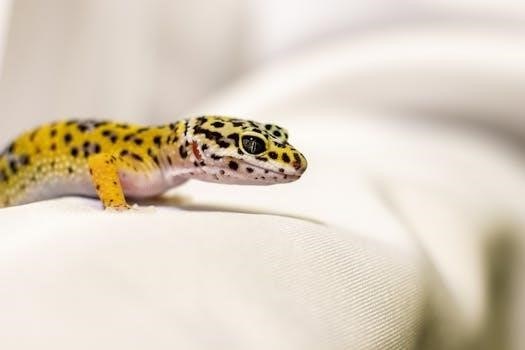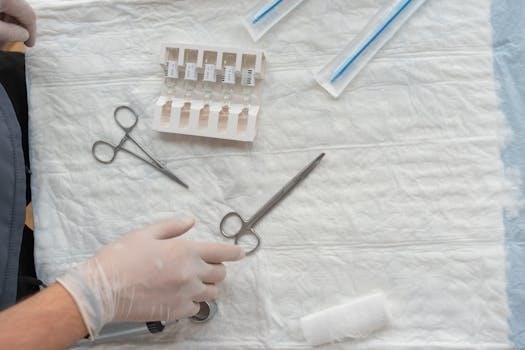Leopard geckos are popular pets‚ known for being beginner-friendly due to their docile nature and relatively easy care requirements. They are hardy and have a cute appearance‚ making them a great choice for many people. These terrestrial lizards are adapted to dry‚ rocky environments.
Leopard Geckos as Beginner-Friendly Pets

Leopard geckos are often cited as excellent choices for first-time reptile owners‚ and this is largely due to their manageable size‚ calm temperament‚ and relatively simple care requirements. Unlike some other reptiles‚ leopard geckos do not demand extensive or complex care routines‚ making them suitable for individuals or families new to reptile keeping. They are generally easy to handle and their small size means they don’t require enormous enclosures. These geckos are terrestrial‚ meaning they spend the majority of their time on the ground‚ not climbing‚ which simplifies habitat design. Their hardiness contributes to their beginner-friendly status‚ as they are not as sensitive to minor fluctuations in their environment compared to some other exotic pets. Furthermore‚ their dietary needs are straightforward‚ primarily consisting of insects‚ which is easily manageable for most keepers. With a proper understanding of their basic needs‚ these geckos make rewarding and enjoyable companions for both new and experienced reptile enthusiasts.

Essential Enclosure Setup
Creating the correct habitat is crucial for a healthy leopard gecko. A proper enclosure includes selecting the right tank size‚ substrate‚ and appropriate heating and lighting to mimic their natural environment. These elements will contribute to their overall well-being.
Appropriate Tank Size for Leopard Geckos
Choosing the right tank size is essential for the well-being of your leopard gecko. These terrestrial creatures need adequate space to move and explore. A 20-gallon long tank is generally considered the minimum for a single adult‚ but a larger tank‚ such as a 30 or 40-gallon‚ is recommended to allow for more room. The length of the tank is more important than the height‚ as they are not climbers. Providing ample floor space allows for proper temperature gradients and enrichment opportunities‚ such as hides and climbing structures. It’s important to remember that while they may appear small‚ leopard geckos still require a comfortable and spacious living environment. Overcrowding can lead to stress and health issues. Ensure the enclosure allows for easy access for cleaning and maintenance and consider that the size of the tank will directly impact your ability to create a proper setup‚ including a basking area and a cooler zone.
Substrate Options for Leopard Gecko Enclosures
Selecting the right substrate is crucial for the health and comfort of your leopard gecko. The substrate should mimic their natural dry‚ rocky habitat. Avoid loose substrates like sand‚ as they can cause impaction if ingested. Safe and recommended options include reptile carpet‚ paper towels‚ or non-adhesive shelf liner. These are easy to clean and don’t pose a risk of ingestion. You can also use ceramic tiles or slate‚ which retain heat well and are easy to sanitize. If using tiles or slate‚ provide a layer of paper towel underneath to prevent the gecko from lying directly on the cold surface. Do not use substrates like wood shavings or bark‚ as these can harbor bacteria and cause respiratory issues. Ultimately‚ the substrate should be safe‚ easy to maintain‚ and provide a comfortable surface for your gecko to live on. Remember to avoid using anything dusty or potentially harmful.
Heating and Lighting for Leopard Geckos
Proper heating and lighting are vital for a leopard gecko’s well-being. These reptiles are ectotherms‚ relying on external heat sources to regulate their body temperature. The ideal basking temperature should be around 88-92°F (31-33°C)‚ with a cooler side of the enclosure at 75-80°F (24-27°C). Use a heat mat or ceramic heat emitter to provide under-tank heating‚ ensuring it covers only one-third of the tank to create a temperature gradient. Avoid using heat rocks‚ which can cause burns. Leopard geckos don’t require UVB lighting‚ as they are nocturnal‚ but a low-wattage LED can be used for a day/night cycle. A basking lamp should be guarded to prevent burns; Monitor temperatures with a thermostat and digital thermometers. The heat source should be placed so they are not accessible to the gecko‚ and the temperatures should be checked regularly.

Leopard Gecko Health and Well-being
Maintaining the health of a leopard gecko involves specific care‚ including proper shedding and humidity levels. Monitoring for common health issues and ensuring preventative measures will help them thrive and live long lives.
Proper Shedding and Humidity
Leopard geckos require proper humidity levels to facilitate successful shedding. A humid hide box should be provided‚ typically located on the warm side of the enclosure. This hide helps the gecko retain moisture‚ which is crucial for shedding. If the humidity is too low‚ the gecko can experience shedding problems‚ such as stuck shed‚ which can cause health issues. Signs of shedding include a dull appearance and a whitening of the skin. Misting the enclosure lightly can also help maintain suitable humidity levels. When a leopard gecko is shedding‚ it is best to leave them alone so they can shed naturally. If any shed gets stuck‚ it’s best to help them by placing them in a shallow‚ warm water bath and using a cotton swab to gently help remove the stuck shed. Regular monitoring of humidity levels‚ especially during shedding‚ is crucial for a healthy gecko.
Common Health Issues and Prevention
Leopard geckos‚ like all reptiles‚ are susceptible to certain health issues if not cared for properly. Metabolic bone disease (MBD) is a common concern‚ often caused by inadequate calcium intake or insufficient UVB lighting. This can lead to bone deformities and weakness. Stuck shed‚ where the gecko has difficulty removing its old skin‚ can result in constriction of limbs and digits‚ which can be quite painful. Respiratory infections‚ parasites‚ and improper diets can also cause health problems. Prevention starts with maintaining appropriate environmental conditions‚ including proper temperature gradients and humidity levels. A balanced diet rich in calcium and other essential nutrients is crucial. Regular veterinary check-ups and immediate attention to any changes in behavior or appearance will help detect and address issues early on.

Feeding and Diet
A leopard gecko’s diet should consist of live insects‚ such as crickets‚ mealworms‚ and dubia roaches. These should be gut-loaded with nutritious food before feeding. A proper diet is essential for their health and well-being and prevents health problems.
Dietary Needs of Leopard Geckos
Leopard geckos are insectivores‚ meaning their primary diet consists of insects. It’s crucial to offer a variety of appropriately sized insects‚ such as crickets‚ mealworms‚ and dubia roaches‚ ensuring they are gut-loaded with nutritious food before feeding. This process enhances the nutritional value for your gecko. Dusting insects with calcium and vitamin D3 supplements is also essential‚ particularly for young and breeding geckos to prevent metabolic bone disease. The frequency of feeding depends on the gecko’s age; juveniles require daily feeding‚ while adults can be fed every other day. It’s important to monitor your gecko’s weight and adjust feeding accordingly. Avoid overfeeding‚ as obesity can lead to other health complications. Always provide fresh water in a shallow dish. A varied and balanced diet is paramount to maintaining the overall health and well-being of your leopard gecko‚ supporting their growth and bodily functions. Do not provide any other type of food other than insects.